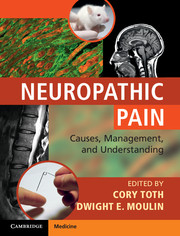Book contents
- Neuropathic Pain
- Neuropathic Pain
- Copyright page
- Contents
- Contributors
- Preface
- Section 1 The Clinical Presentation of Neuropathic Pain
- Section 2 The Condition of Neuropathic Pain
- Section 3 The Specific Condition: Peripheral Neuropathic Pain
- Section 4 The Specific Condition: Central Neuropathic Pain
- Chapter 12 Neuropathic pain following spinal cord injury
- Chapter 13 Central pain symptoms in multiple sclerosis
- Chapter 14 Central post-stroke pain
- Section 5 The Specific Condition: Other Causes of Neuropathic Pain
- Section 6 The Management of Neuropathic Pain
- Section 7 The Prognosis of Neuropathic Pain
- Index
Chapter 12 - Neuropathic pain following spinal cord injury
from Section 4 - The Specific Condition: Central Neuropathic Pain
Published online by Cambridge University Press: 05 December 2013
- Neuropathic Pain
- Neuropathic Pain
- Copyright page
- Contents
- Contributors
- Preface
- Section 1 The Clinical Presentation of Neuropathic Pain
- Section 2 The Condition of Neuropathic Pain
- Section 3 The Specific Condition: Peripheral Neuropathic Pain
- Section 4 The Specific Condition: Central Neuropathic Pain
- Chapter 12 Neuropathic pain following spinal cord injury
- Chapter 13 Central pain symptoms in multiple sclerosis
- Chapter 14 Central post-stroke pain
- Section 5 The Specific Condition: Other Causes of Neuropathic Pain
- Section 6 The Management of Neuropathic Pain
- Section 7 The Prognosis of Neuropathic Pain
- Index
Summary
- Type
- Chapter
- Information
- Neuropathic PainCauses, Management and Understanding, pp. 145 - 155Publisher: Cambridge University PressPrint publication year: 2013
- 2
- Cited by



